
Menemerus davidi is a species of jumping spider in the genus Menemerus that lives in North Africa and the Middle East. The species was first identified in 1999 by Jerzy Prószyński and Wanda Wesołowska working initially independently, and then together. The first description was published by Wesołowska, one of over 500 descriptions she produced during her lifetime. The spider is small, with a carapace that ranges between 2.3 and 3.0 millimetres long and an abdomen that is 2.2 and 3.2 millimetres long, although the female is larger than the male. The carapace is generally a uniform dark brown while the abdomen has a pattern of a light brown stripe and white patches that serves to distinguish it from the related Menemerus animatus. Otherwise, it is its copulatory organs that most distinguish the species from others in the genus. It has distinctive internal structure to the female epigyne. The wide copulatory openings lead down the centre of the spider to the spermathecae while there is also a short narrower channel that runs to the rear of the spider with a prominent scent pore at the end. The male has a noticeably smaller embolus and a distinctive dorsal tibial apophysis.

Menemerus desertus is a species of jumping spider in the genus Menemerus that lives in Algeria. The species was first described in 1999 by Wanda Wesołowska, one of over 500 descriptions she produced during her lifetime. The spider is small, with a carapace that ranges between 2.5 and 2.7 millimetres long and an abdomen that is 2.7 and 4.7 millimetres long, although the female is larger than the male. The carapace is generally a uniform dark brown while the abdomen has a yellow stripe. Otherwise, it is its copulatory organs that most distinguish the species from others in the genus. The female epigyne has ridges at the entrance to the insemination ducts. The male has a distinctive dorsal tibial apophysis.

Menemerus modestus is a species of jumping spider in the genus Menemerus that lives in Tunisia. The species was first identified in 1999 by Wanda Wesołowska, one of over 500 descriptions she produced during her lifetime. The spider is mainly a diurnal hunter. It is small, with a brown carapace that is typically 2.2 millimetres (0.087 in) long and a light abdomen 2.1 millimetres (0.083 in) long. The male has a distinctive configuration of two appendages at the base of the palpal bulb, or apophyses, one larger and bulbous, the other a short spike. The female has not been described.
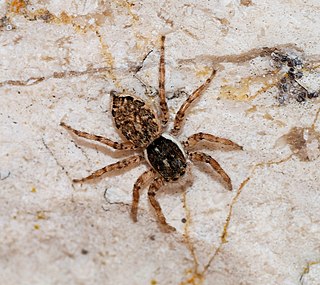
Menemerus bifurcus is a species of jumping spider in the genus Menemerus that lives in South Africa, Zambia and Zimbabwe. The species was first described in 1999 by Wanda Wesołowska, one of over 500 descriptions she has written during her lifetime. The spider lives in groups in Acacia, Combretum, Jacaranda, Spathodea and Trichilia trees as well as in houses and other areas of human habitation. It descends to attack prey on long threads of silk. It is a small spider, with a carapace that is between 1.9 and 2.3 millimetres long and an abdomen between 1.9 and 2.5 millimetres long. The female is larger than the male and generally lighter, ranging generally from fawnish-brown to dark brown. The species is similar to Menemerus formosus and Menemerus transvaalicus but differs in the design of its copulatory organs. The male has a short embolus with a longer lamella, which is recalled in the species name, and two distinctive tibial appendages, or apophyses, one with a characteristic triangular lobe. Examples found in Zimbabwe have one longer tibial apophysis. The female has a heart-shaped depression in the epigyne and an unusual insemination duct morphology.

Menemerus formosus is a species of jumping spider in the genus Menemerus that lives in Kenya. The species was first described in 1999 by Wanda Wesołowska, one of over 500 descriptions she has written during her lifetime. It is a small spider, with a brown carapace that is between 2.0 and 2.3 millimetres long, with a darker eye field that is between 1.0 and 1.2 millimetres long, and a yellowish abdomen between 1.9 and 2.3 millimetres long. The female is larger than the male and has a pattern of silver patches on its abdomen. The legs are yellow. The species is similar to Menemerus bifurcus, Menemerus magnificus and Menemerus transvaalicus but differs in the design of its copulatory organs. The male has a conductor that curves over its short embolus. The female has an epigyne that has a shallow depression and a furrow with a wide pocket.

Menemerus minshullae is a species of jumping spider in the genus Menemerus that lives in South Africa, Malawi and Zimbabwe. The species was first described in 1999 by Wanda Wesołowska, one of over 500 descriptions she has completed during her lifetime. She originally identified the male as a different species, named Menemerus manicus, but merged the two in 2007. It is small to medium-sized spider with a cephalothorax that is between 1.9 and 2.2 millimetres long and an abdomen between 2.1 and 3.3 millimetres long. The female is larger than the male and lighter, with a dark brown rather than black carapace and lighter brown abdomen. The abdomen has a large, leaf-shaped, pattern. It lives on Vachellia xanthophloea trees, using its flattened shape to hide under flakes of bark. The copulatory organs distinguish the species from others in the genus. The male has a very short embolus with a larger accompanying conductor. The female epigyne has two pockets that have strongly sclerotized edges.
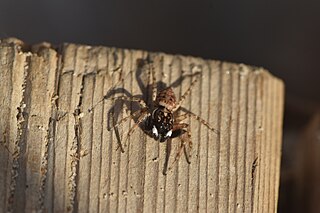
Menemerus meridionalis is a species of jumping spider in the genus Menemerus that lives in South Africa. The species was first described in 1999 by Wanda Wesołowska, one of over 500 descriptions she produced during her lifetime. The spider is small, with a carapace that is typically 2.8 millimetres (0.11 in) long and an abdomen 3.3 millimetres (0.13 in) long. The carapace is generally dark brown with a white stripe down the middle while the abdomen has a dark brown stripe. Otherwise, it is its copulatory organs that most distinguish the species from others in the genus. The male has a lumpy retrolateral tibial apophysis, similar to but smaller than Menemerus tropicus, and a very small spiked ventral tibial apophysis.

Menemerus magnificus is a species of jumping spider in the genus Menemerus that lives in Cameroon. The species was first described in 1999 by Wanda Wesołowska, one of over 500 descriptions she wrote during her lifetime. The spider is small, with a carapace that is typically 1.2 millimetres (0.05 in) long and an abdomen that is 1.8 millimetres (0.07 in) long. The carapace is generally a uniform dark brown while the abdomen has two rows of patches on the back. Otherwise, it is its copulatory organs that most distinguish the species from others in the genus. The male has a distinctive dorsal tibia that includes horn-like appendages, or apophyses, and lobes. The female has not been described.
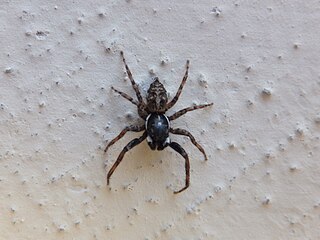
Menemerus mirabilis is a species of jumping spider in the genus Menemerus that lives in Ethiopia in areas of human habitation, including a house and a hotel. The species was first described in 1999 by Wanda Wesołowska. The spider is small and brown, with a carapace that is between 1.8 and 2.4 millimetres long and an abdomen between 2.0 and 3.5 millimetres long. The female has a larger and lighter abdomen than the male. The male has an indistinct leaf-shaped pattern on its abdomen. It is similar to other species in the genus but can be distinguished by its copulatory organs. The male has a shorter embolus than other species. The female can be identified by the two depressions in its epigyne and its circular spermathecae.

Menemerus zimbabwensis is a species of jumping spider in the genus Menemerus that lives in South Africa and Zimbabwe. The Polish arachnologist Wanda Wesołowska first described the female in 1999 and the male in 2007. The spider is large, with a cephalothorax that is between 1.9 and 3.2 millimetres long and an abdomen that is between 2.1 and 4.6 millimetres in length. The female is larger than the male. It also lacks the light stripe down the centre of its dark brown carapace and has a less distinct pattern on its abdomen. Its legs and pedipalps are yellow, while on the male they are brown. The male can be distinguished from the similar Menemerus nigli by the wide stripe on its abdomen. The female is harder to identify without looking at its copulatory organs. These are distinctive. It has characteristic large entrance bowls on its epigyne, which are larger than the insemination ducts and spermathecae combined. Its internal organs are very sclerotized.

Menemerus animatus is a species of jumping spider in the genus Menemerus that lives across the Mediterranean Basin and into the Afrotropical realm. The species was first described in 1876 by Octavius Pickard-Cambridge based on an example from Egypt. It has subsequently been found living across many countries from Algeria to Greece and Senegal to Yemen. It prefers living in sandy environments.

Menemerus soldani is a species of jumping spider in the genus Menemerus that lives in Algeria, Egypt and Tunisia. It was first described in 1826 by Jean Victor Audouin. He identified both the male and female but not in much detail and it was not until 1999 that a thorough description was completed. This led to confusion, with many museums holding examples of different species labelled Menemerus soldani. When the female was described by Hippolyte Lucas and Wanda Wesołowska, they were designated as different species, both of these being declared junior synonyms by subsequent arachnologists. The spider is small, with a total length between 3.11 and 5.65 mm, and has a brown carapace, yellow abdomen and orange legs. The spiders have characteristic copulatory organs. The female has a characteristic semi-circular notch at the rear of its epigyne while the male has a large bulbous patellar apophysis that other species in the genus lack. The male has a flat projection or apophysis on its pedipalp tibia. The spider lives in palm groves and Quercus suber forests.
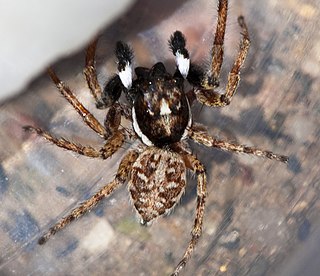
Menemerus pulcher is a species of jumping spider in the genus Menemerus that lives in Mauretania. The species was first described in 1999 by Wanda Wesołowska. The spider is small and brown, with an atypically high carapace that is 2.6 millimetres (0.10 in) long and an abdomen 2.8 millimetres (0.11 in) long. There is a white stripe running down the back of the otherwise brown carapace. The abdomen is yellowish-fawn with a dark pattern that is reminiscent of a fleur-de-lis and more rounded than other spiders in the genus. Otherwise, it is externally similar to Menemerus plenus, although it can be distinguished by its copulatory organs. The male has a double embolus and two large parallel retrolateral apophyses, or appendages. The female has not been described.

Menemerus regius is a species of jumping spider in the genus Menemerus that lives in Ethiopia. The species was first identified in 1999 by Wanda Wesołowska. The spider has been found living in low vegetation, on trees and in houses. It is small, with a brown hairy carapace that is between 1.9 and 2.4 millimetres long and a yellowish-grey or greyish-beige abdomen that is between 2.1 and 3.0 millimetres in length. The female is slightly larger than the male. The carapace has a large yellowish patch and the abdomen a stripe down the middle. The spider has yellow legs. The spider is similar to others in the genus. However, its copulatory organs are distinctive. The male lacks the ventral tibial apophysis normally found on its palpal bulb and instead has an unusual double tibial apophysis with one bulbous appendage and the other shaped like a horn. The female has a characteristic shape to its epigyne with two rounded depressions to the front and a noticeable notch to the rear.
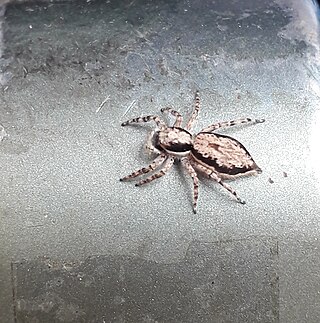
Menemerus nigeriensis is a species of jumping spider in the genus Menemerus that lives in Nigeria. The species was first described in 2011 by Wanda Wesołowska and Anthony Russell-Smith based on a holotype found near Ibadan. The spider is medium-sized, with a cephalothorax that is typically 2.5 millimetres (0.10 in) long and an abdomen 2.6 millimetres (0.10 in) long. The carapace is generally a uniform dark brown, the eye field black and the abdomen greyish-brown. As with other Menemerus spiders, it is its copulatory organs that most distinguish the species from others in the genus. The male has a distinctive dorsal tibia that has a very long and pointed apophysis or appendage. The female has not been identified.
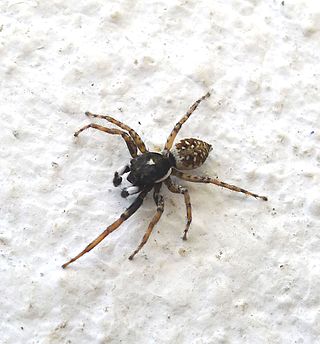
Menemerus pallescens is a species of jumping spider in the genus Menemerus that lives in Yemen. The spider was first described in 2007 by Wanda Wesołowska and Antonius van Harten. Other examples have been found in the Emirate of Dubai. The spider is medium sized with a carapace that is between 2.5 and 3.1 mm long and abdomen between 3.4 and 4.2 mm long. The carapace is dark brown with white stripes at the back. The abdomen is yellowish-beige or light grey, sometimes with a pattern of lines and spots. The legs are yellow. The spider is hard to distinguish from others in the genus without a study of its copulatory organs. The spider has a shallow notch at rearmost edge of its epigyne and long accessory glands. The male has not been described.

Menemerus patellaris is a species of jumping spider in the genus Menemerus that lives in Yemen. The spider was first described in 2007 by Wanda Wesołowska and Antonius van Harten. The spider is medium sized with a carapace that is typically 2.6 mm (0.10 in) long and abdomen between 2.9 mm (0.11 in) long. The carapace is brown with white stripes on the edges. The abdomen is yellowish-beige, while the legs are yellow. The spider is hard to distinguish from others in the genus without a study of its copulatory organs. It has a very short embolus and a distinctive furrow in its tegulum dividing a sac of tissue used in copulation called the haematodocha. In addition to the spike, or apophysis on its tibia, it has another one on the patellar, the section between the tibia and the palpal bulb.
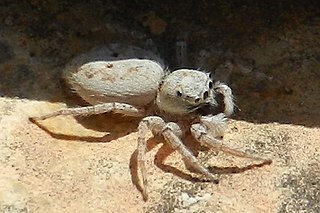
Menemerus affinis is a species of jumping spider in the genus Menemerus that lives in the United Arab Emirates. The spider is externally hard to tell apart from the related Menemerus arabicus or Menemerus fagei; this affinity is reflected in the species name. The spider was first described in 2010 by Wanda Wesołowska and Antonius van Harten based on a holotype discovered in Ras Al Khaimah. Other examples have been found in Dubai. The spider is medium sized with a brown cephalothorax that is between 2.7 and 2.9 mm long and a greyish-brown abdomen between 3.1 and 4.0 mm long. It has brown legs. The female is larger than the male and has an epigyne with a large pocket to the front and a notch at the back. The male copulatory organs has an embolus paired to a large secondary conductor and two spikes, or apophyses, on the pedipalp tibia.
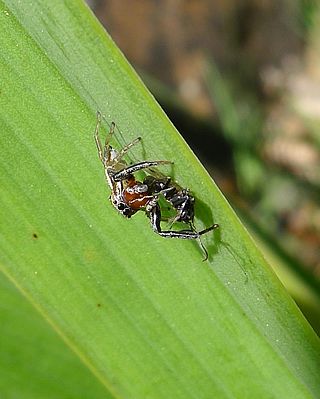
Menemerus tropicus is a species of jumping spider in the genus Menemerus that lives in Kenya and Uganda near Lake Victoria. The spider lives in large nest complexes that can stretch between trees in mangrove savannas. The species was first described in 2007 by Wanda Wesołowska, one of over 500 descriptions she has written during her lifetime. It is a small spider, with a flattened cephalothorax that is between 1.7 and 2.1 mm and a rounded abdomen between 1.7 and 2.9 mm long. The female is larger than the male and has a darker abdomen and lighter carapace. The male abdomen has a pattern that includes a brown streak and silver spots. The female has a yellowish streak, in some examples, with yellow patches. The legs are brown and yellow. The copulatory organs help distinguish the species from others in the genus. The male has a very short double embolus and very large retrolateral apophysis. The female has a narrower pocket in its epigyne, narrow insemination ducts and small spherical spermathecae.

Menemerus cummingorum is a species of jumping spider in the genus Menemerus that lives in Zimbabwe. The species was first described in 2007 by Wanda Wesołowska, one of over 500 descriptions she has written during her lifetime. It is medium-sized spider, with a flattened cephalothorax that is between 2.2 and 2.4 mm and an oval abdomen between 2.3 and 2.9 mm long. The female has a larger abdomen than the male. It is also dark brown and marked with a large yellow leaf-shaped pattern compared to the yellowish-grey of the male. Both the male and female have a dark brown carapace, with a pattern of white streaks, a line and five patches, although the pattern is more pronounced on the male. It has yellow legs, the foremost pair being darker and having brown patches. It is similar to the related Menemerus minshullae, but larger.

















